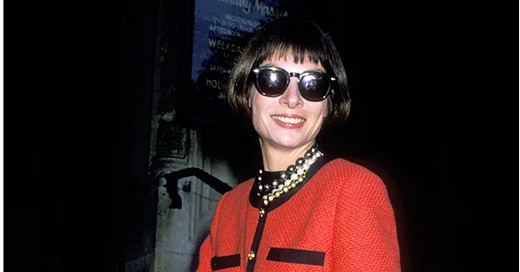Anna Wintour Will Always Be Vogue
For American Vogue's all-important editor-in-chief, it is not exactly good-bye.
Anna Wintour stepping down from serving as American Vogue’s editor-in-chief prompted me to think back to how I took a mental picture of her look when we first exchanged words. Her elegance left such a deep impression that it became my North Star as I worked my way up in glossy magazines.
Interviewing Wintour was one of my first ever fashion journalism assignments. It wasn’t a sit down, formal affair and it preceded The Devil Wears Prada by 10 years. It all started when my editor at the European Newspaper tasked me with stopping Wintour in her Manolos during Milan Fashion Week. It was my job to get her opinion on the clothes showcased in the Italian fashion capital. I wasn’t exactly game for the challenge. I had no choice. I also had to talk to Wintour’s rival, Liz Tilberis - then the editor of U.S. Harper’s Bazaar - and British Vogue’s Alexander Shulman. She eventually became my boss.
Just as things were getting started at Fiera Milano, where the shows took place, Wintour was walking toward me, making her way out of the café. Immaculately clad in a red Chanel suit by Karl Lagerfeld, she was hard to miss.
She was also alone. I must have been on a caffeine high because promptly I stepped forward and cobbled together some sort of greeting. She stopped and let me fire away with questions.
As for Wintour’s answers, I can’t remember exactly what she said. But I do recall that in the span of no more than three minutes she told me everything about why Milan fashion mattered. Amid our conversation, she mentioned something about a designer “pushing fashion forward.” It was the first time I heard anyone use the phrase. She was friendly and perfectly coiffed.
Five years later, when I was working at British Vogue, I became a regular at Chanel’s annual sample sales and acquired a Manolo Blahnik footwear collection, which continues to proliferate. Thanks to a John Frieda platinum card, I went to the hair salon every other day. Whenever any young fashion professional or trainee journalist asks me for advice, I answer their questions.
We could all take Wintour to task for staying for too long at the top of American Vogue’s masthead. She’s staying there because, after she selects her successor, she’ll remain Vogue’s global editorial director and Condé Nast’s global chief content officer. That will surely complicate matters for whoever gets her former job, unless it’s Bee Shaffer Carrozzini, Wintour’s daughter.
Forbes has mentioned other editors who may be in the running to succeed her, including AD’s Amy Astley and British Vogue’s Chioma Nnadi. My friend, Merle Ginsberg mentioned Lindsay Peoples as another possibility. The editor of New York Magazine’s The Cut is a former editor-in-chief of Teen Vogue. With Sandrine Charles, Peoples co-founded the organization, Black in Fashion Council, which holds the fashion industry accountable for change related to race and inclusion.
Wintour’s Vogue was too much of a closed shop as fashion became entertainment and new media democratized the designer fashion system she championed. Back in the noughties, when I was covering the Oscars red carpet for BBC’s flagship news show, Breakfast, I scratched my head about why - as Hollywood’s red carpet became a must-watch fashion runway - not one A-list celebrity stylist was ever put on American Vogue’s masthead.
After I left British Vogue and was covering New York Fashion Week, I bumped into Susanna Lau, who was blogging under the name “Susie Bubble.” It was 2010 and I wondered why she or Tavi didn’t have a Vogue column. Instead American Vogue generated headlines in 2016, when four editors complained about the presence of bloggers during Milan Fashion Week. “Note to bloggers who change head-to-toe, paid-to-wear outfits every hour: please stop. Find another business. You are heralding the death of style,” stated one of them.
Not exactly. Bloggers gave rise to social media influencers who crushed the power of legacy media editors, Wintour included.
For decades, however, masterful fashion photography defined Wintour’s Vogue. There are too many photographers who became stars during her tenure to name here. She championed women in politics and athletics like no other magazine editor. After orchestrating the rise of John Galliano and Alexander McQueen to resurrect Dior and Givenchy, respectively, her guidance helped to regenerate Louis Vuitton, Céline and Loewe because designers she recommended to helm the luxury brands - namely, Marc Jacobs, Michael Kors and Narciso Rodriguez - revitalized them.
As we all know, Wintour also transformed the Met Gala to be an all important annual fashion forum that showcases the craft and creativity of countless fashion names, among them independents from Brandon Maxwell to Erdem and Grace Wales Bonner, whose work is seen here, adorning Jeff Goldblum.
In the midst of it all, Wintour starred in The September Issue and The First Monday In May. The box office success of the fashion documentaries helped the medium to flourish.
The gorgeous British editor-in-chief will also go down in history because she made Vogue something it never was before until she helmed it and forever will be - completely synonymous with the name Anna Wintour.








